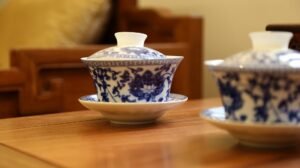Chinese porcelain, prized for its beauty and creativity, has long been seen to represent Chinese heritage. This essay examines Chinese porcelain’s long history, its different artistic movements, and its significance in world trade.
Table of Contents
ToggleThe Birth of Porcelain
Porcelain’s beginnings can be found in China’s Eastern Han Dynasty (东汉 – Dōng Hàn, 25-220 CE) when artisans first used kaolin clay (高岭土 – gāolǐng tǔ) to make delicate, translucent ceramics. These early works of art served as the starting point for the evolution of porcelain into what it is today.
The Evolution and Development
Tang Dynasty (唐朝 – Tángcháo)
Chinese porcelain underwent tremendous technological and artistic improvements during the Tang Dynasty (618–907 CE). Stronger, longer-lasting objects were produced as a result of the introduction of high-fired ceramics, also referred to as “true porcelain” (真瓷 – zhēn cí).
Song Dynasty (宋朝 – Sòngcháo)
When the renowned “five great kilns” (五大名窑 – wǔ dà míng yáo) were developed during the Song Dynasty (960–1279 CE), Chinese porcelain had a golden age. A thriving porcelain art and industry resulted from the kilns’ production of extraordinary pieces with distinctive glazes (釉料 – yòu liào) and processes.
Ming Dynasty (明朝 – Míngcháo)
Chinese porcelain reached new heights of refinement and received widespread admiration during the Ming Dynasty (1368–1644 CE). The famous blue-and-white porcelain style (青花瓷 – qīng huā cí) was developed thanks to imperial court (皇室 – huángshì)sponsored porcelain workshops (瓷器作坊 – cíqì zuòfáng). This design is still in use today.
Qing Dynasty (清朝 – Qīngcháo)
Further technological and artistic improvements in porcelain were made during the Qing Dynasty (1644–1911 CE). During this time, the Famille rose (粉彩 – fěn cǎi) and famille verte (五彩 – wǔ cǎi) porcelain designs with their exquisite enamel work (珐琅 – fǎ láng) and vivid color schemes came into being.

The Art of Chinese Porcelain
Styles and Techniques
The variety of styles, processes, and glazes used in Chinese porcelain is well known. Celadon (青瓷 – qīng cí), blue-and-white (青花瓷 – qīng huā cí), and famille rose (粉彩 – fěn cǎi) are the most well-known designs. On porcelain objects, elaborate designs and motifs have been created using methods such as underglaze painting (釉下彩 – yòu xià cǎi), overglaze enameling (釉上彩 – yòu shàng cǎi), and carved relief (浮雕 – fú diāo).
Symbolism and Motifs
Chinese porcelain frequently includes designs and symbols that have great cultural significance. Dragons (龙 – lóng), phoenixes (凤凰 – fènghuáng), flowers (花 – huā), and landscapes (山水 – shānshuǐ) are typical themes that signify strength, rebirth, beauty, and harmony, respectively.
Chinese Porcelain in Global Trade
The Silk Road (丝绸之路 – Sīchóu zhī lù)
Chinese porcelain was a major component of international trade, especially along the Silk Road. This historic trade route allowed for the flow of products, concepts, and cultural elements between China, the Middle East, Europe, and Africa. Along the Silk Road, porcelain was a highly prized item, and its export contributed to the globalization of Chinese art and craftsmanship.
European Demand and Influence
When explorers and traders returned from the East with exotic riches, the 16th century saw the beginning of the demand for Chinese porcelain in Europe. The nobility of Europe immediately adopted porcelain as a status symbol, which prompted the development of numerous porcelain factories across the continent to imitate Chinese methods. The emergence of the chinoiserie style in the 17th and 18th centuries is evidence that the popularity of Chinese porcelain also impacted European art and design.
Conclusion
Chinese porcelain is a national treasure representing the country’s artistic talent and fine craftsmanship. Its growth and development over several dynasties have molded and enriched its creative styles and techniques, which has continued to draw collectors and fans from all over the world. Chinese porcelain’s importance in international trade also emphasizes the long-lasting effect of Chinese culture.
Our Summer Camp offers a unique opportunity for students to explore Chinese culture and learn about the history and artistry of porcelain. The Summer Camp is open to students of 7–17 ages and skill levels who are passionate about learning about Chinese culture, history, art, Chinese porcelain, etc.
Do I need any prior experience in porcelain painting or pottery to join the camp?
Prior experience in porcelain painting or pottery is optional. The camp is designed to accommodate students of all skill levels.
What is the duration of the Chinese School Summer Camp?
The camp typically runs for nine weeks, from June 19th to August 7th, 2023.
How often are the classes held during the 9-week program?
Several classes are usually held each week as part of the program. For further details about the class schedule, kindly contact the Chinese School directly or visit our website.
REGISTER for our SUMMER CAMP in 2023!
Learn about our Internship Program in China.
Learn about holidays in China in 2023.
Get free Chinese learning resources.
Read about the Spring Festival Celebration on NRK’s website: https://www.nrk.no/norge/harens-ar-1.16270652#top.









